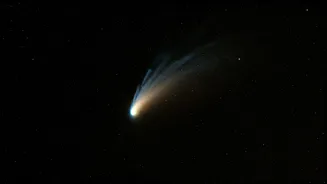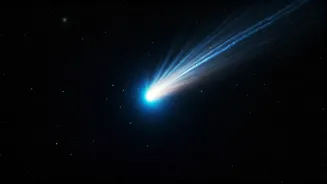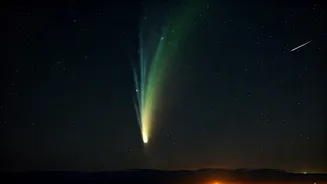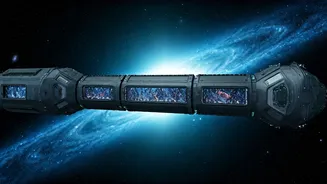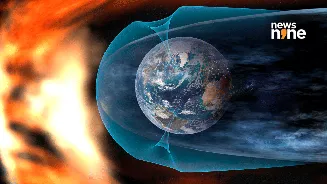Comet's Grand Journey
Comet C/2025 R2 (SWAN), a celestial traveler, embarked on a long journey, eventually approaching our planet. Its journey, a path governed by the gravitational
pull of the Sun and other celestial bodies, led it toward Earth. The comet's trajectory is a significant aspect of its observation, determining when and where it will be visible. The comet’s path means it won't be visible throughout the entire night. It’s expected to be a morning object, rising before the sun. This positioning provides a crucial window of opportunity for viewers. Knowing its predicted route allows astronomers and amateur enthusiasts to prepare their equipment, plan viewing sessions, and track its progress across the sky. The date of October 21st marks its closest point to Earth, but the comet is expected to be visible for several weeks, offering multiple viewing opportunities. Weather conditions will play a significant role in visibility. Clear skies are necessary for spotting this distant wanderer, making local weather forecasts essential for planning.
Finding the Comet
Locating Comet C/2025 R2 (SWAN) requires some preparation and knowledge of the night sky. The comet’s position in the sky isn't static, and it will shift slightly each day. Understanding where to look necessitates the use of star charts, astronomy apps, or online resources. These tools provide real-time information about the comet’s location relative to constellations and bright stars, making the search less daunting. To begin, find the constellation where the comet is predicted to appear. Once located, the comet might appear as a faint, fuzzy patch of light. It's often helpful to scan the area with binoculars or a telescope. These instruments enhance the comet's visibility and reveal more details like its tail. Patience is key. Light pollution in cities poses a challenge. Dark locations far from city lights are ideal. Finding a spot with a clear horizon and minimal obstructions will also increase your chances of spotting the comet.
Observing Without Equipment
Even without specialized equipment, Comet C/2025 R2 (SWAN) might still be visible under favorable conditions. A dark location is crucial. Away from city lights, with minimal light pollution, the comet's faint glow becomes easier to detect with the naked eye. Give your eyes time to adjust to the darkness. It takes about 20-30 minutes for your eyes to fully adapt to the dark, maximizing your ability to perceive faint objects. Look for a hazy, diffused patch of light in the sky. It might resemble a faint smudge. The comet's tail, if sufficiently bright, might extend behind it. Scanning the sky methodically can help. Slowly scan the area where the comet is expected. Use the same technique as you would when searching for meteor showers. Observe for longer periods. The more time you spend observing, the better your chances of spotting the comet. Even if it's not a spectacular sight, experiencing a celestial event like this with the naked eye is a memorable experience.
Using Binoculars & Telescopes
Enhance your viewing experience by employing binoculars or a telescope. Binoculars offer a wider field of view, making it easier to locate the comet and see it in context with surrounding stars. Choose binoculars with a magnification of 7x or 10x, and a lens diameter of 50mm. This configuration provides a good balance between magnification and light-gathering capability, thus improving visibility. Telescopes provide a more detailed view, revealing the comet's nucleus, coma, and any possible tail structures. A telescope with a focal length of around 600-800mm is ideal for viewing comets. Set up your equipment ahead of time, ensuring it is properly focused. Familiarize yourself with the controls before the event. Align the telescope with the expected location of the comet, using the star charts or astronomy apps. When using a telescope, start with a low-power eyepiece to find the comet. Gradually increase the magnification as the comet comes into view. Remember to focus on the comet's nucleus, which might appear as a bright point of light. The tail can be more challenging to spot, requiring patience and good observing conditions. Keep an eye out for atmospheric interference, as this can affect the clarity of the view.
Best Viewing Tips
Several factors contribute to a successful viewing session. The timing is essential. Consult astronomy resources for the exact time the comet will be visible in your area. This will vary depending on your location and the comet’s path. Check the weather forecast for clear skies. Cloud cover can completely obscure the comet, rendering your efforts futile. Locate a viewing spot away from light pollution. The darker the location, the better your chances of seeing the comet. Pack essential items. Bring a red light flashlight to preserve your night vision. Dress warmly, as nighttime temperatures can drop significantly. Also, consider bringing a comfortable chair and some snacks. Take breaks. Stargazing can be tiring. Take breaks to rest your eyes and stretch. Bring friends. Sharing the experience with others enhances the enjoyment and creates lasting memories. Record your observations. Take notes of what you see. Take photographs or videos of the comet using a smartphone or a camera. Don't be disappointed if the comet doesn't appear as spectacular as in professional images. Comets can vary widely in brightness. Focus on enjoying the experience of observing a celestial wonder.
